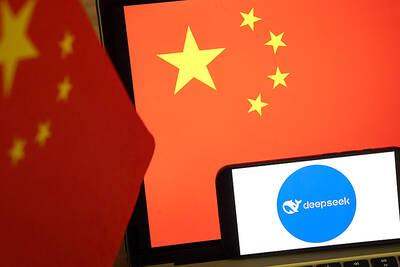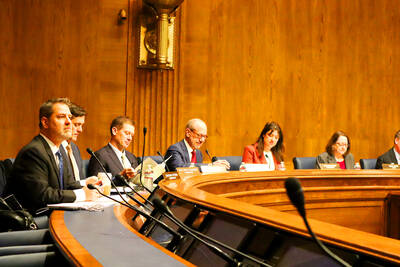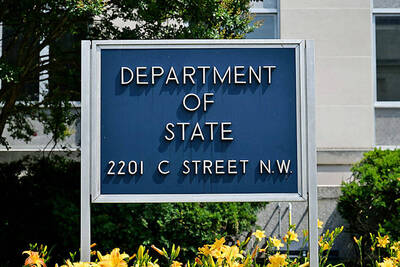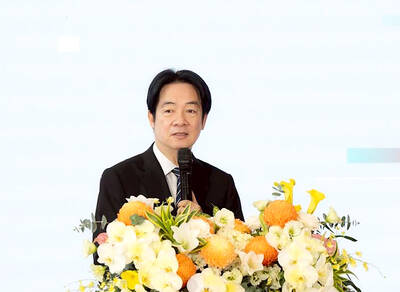The Pentagon is planning to move a number of armed drone aircraft to its Pacific Command force from where they could be used in part to support Taiwan’s security and guard against a surprise attack by China.
Equipped with state-of-the-art surveillance cameras, the Predator and Reaper unmanned aerial vehicles (UAV) would monitor China’s military buildup and North Korea’s nuclear and missile programs.
Quoting a Pentagon official, the Washington Times reported earlier this week that a special task force at the US Joint Chiefs of Staff was studying the move.
The UAV would become available in the coming months as the US draws down forces from theaters in Afghanistan, Pakistan and Iraq.
While it is still not clear just how many drones would be involved, Pentagon plans call for a total worldwide force of 33 Predators and 32 Reapers — and support staff of about 12,000 — to be flying over the next few years.
They have a budget of about US$5 billion this year.
The Predator costs about US$5 million per unit, while the Reaper is about US$10.5 million per aircraft.
Military sources said the Predators and Reapers, which can stay up for 24 hours at a speed of 644kph, would most likely be stationed in South Korea and Okinawa, Japan.
Last year, the US military stationed Global Hawk surveillance drones in Guam.
Together with the Global Hawks, the Predator and Reaper drones would monitor the movements of China’s expanding forces, its coastal missile batteries — including those in provinces directly across from Taiwan — and watch remote islands that are claimed by competing Asian countries including Taiwan and China.
John Pike, head of the -Washington-based Global Security think tank, told the Taipei Times that the Predators and Reapers would probably be used to monitor the Chinese coast where they could provide more “persistent” coverage than is provided by spy satellites.
They would be particularly useful, he said, in following Chinese military exercises, including missile drills.
“It all helps Taiwan’s security,” Pike said.
Data gathered by the drones can be transmitted almost instantly to bases on the ground, while they could also fire deadly accurate missiles in emergency situations.
US Air Force Colonel James Sculerati told a conference on military drones this week that future drone missions would include more night flights and flights in difficult weather.
“We already do a lot of work at night. We are going to do more work in weather [and] we are -going to do more work in difficult terrain. We need vehicles that are capable of flying in darkness, in all weather,” he said.
Many analysts believe drones will eventually replace manned fighter aircraft.
While China’s drones are believed to be several years behind US models in development, there are concerns that Beijing could be catching up.
The US-China Economic and Security Review Commission recently reported: “The PLA [People’s Liberation Army] Air Force had deployed several types of unmanned aerial vehicles for both reconnaissance and combat purposes.
“In addition, China is developing a variety of medium and high-altitude long-endurance unmanned vehicles, which when deployed, will expand the PLA Air Force’s options for long-range reconnaissance and strike,” it said.

MISINFORMATION: The generated content tends to adopt China’s official stance, such as ‘Taiwan is currently governed by the Chinese central government,’ the NSB said Five China-developed artificial intelligence (AI) language models exhibit cybersecurity risks and content biases, an inspection conducted by the National Security Bureau (NSB) showed. The five AI tools are: DeepSeek, Doubao (豆包), Yiyan (文心一言), Tongyi (通義千問) and Yuanbao (騰訊元寶), the bureau said, advising people to remain vigilant to protect personal data privacy and corporate business secrets. The NSB said it, in accordance with the National Intelligence Services Act (國家情報工作法), has reviewed international cybersecurity reports and intelligence, and coordinated with the Ministry of Justice Investigation Bureau and the National Police Agency’s Criminal Investigation Bureau to conduct an inspection of China-made AI language

LIMITS: While China increases military pressure on Taiwan and expands its use of cognitive warfare, it is unwilling to target tech supply chains, the report said US and Taiwan military officials have warned that the Chinese People’s Liberation Army (PLA) could implement a blockade within “a matter of hours” and need only “minimal conversion time” prior to an attack on Taiwan, a report released on Tuesday by the US Senate’s China Economic and Security Review Commission said. “While there is no indication that China is planning an imminent attack, the United States and its allies and partners can no longer assume that a Taiwan contingency is a distant possibility for which they would have ample time to prepare,” it said. The commission made the comments in its annual

CHECKING BOUNDARIES: China wants to disrupt solidarity among democracies and test their red lines, but it is instead pushing nations to become more united, an expert said The US Department of State on Friday expressed deep concern over a Chinese public security agency’s investigation into Legislator Puma Shen (沈伯洋) for “secession.” “China’s actions threaten free speech and erode norms that have underpinned the cross-strait ‘status quo’ for decades,” a US Department of State spokesperson said. The Chongqing Municipal Public Security Bureau late last month listed Shen as “wanted” and launched an investigation into alleged “secession-related” criminal activities, including his founding of the Kuma Academy, a civil defense organization that prepares people for an invasion by China. The spokesperson said that the US was “deeply concerned” about the bureau investigating Shen

‘TROUBLEMAKER’: Most countries believe that it is China — rather than Taiwan — that is undermining regional peace and stability with its coercive tactics, the president said China should restrain itself and refrain from being a troublemaker that sabotages peace and stability in the Indo-Pacific region, President William Lai (賴清德) said yesterday. Lai made the remarks after China Coast Guard vessels sailed into disputed waters off the Senkaku Islands — known as the Diaoyutai Islands (釣魚台) in Taiwan — following a remark Japanese Prime Minister Sanae Takaichi made regarding Taiwan. Takaichi during a parliamentary session on Nov. 7 said that a “Taiwan contingency” involving a Chinese naval blockade could qualify as a “survival-threatening situation” for Japan, and trigger Tokyo’s deployment of its military for defense. Asked about the escalating tensions